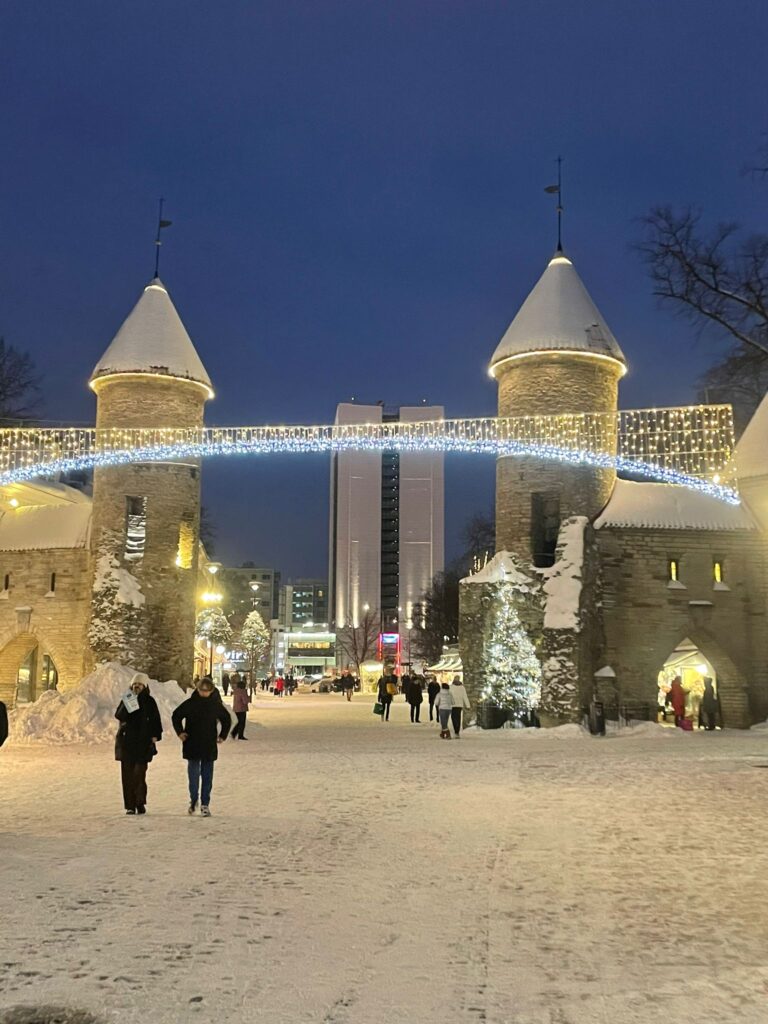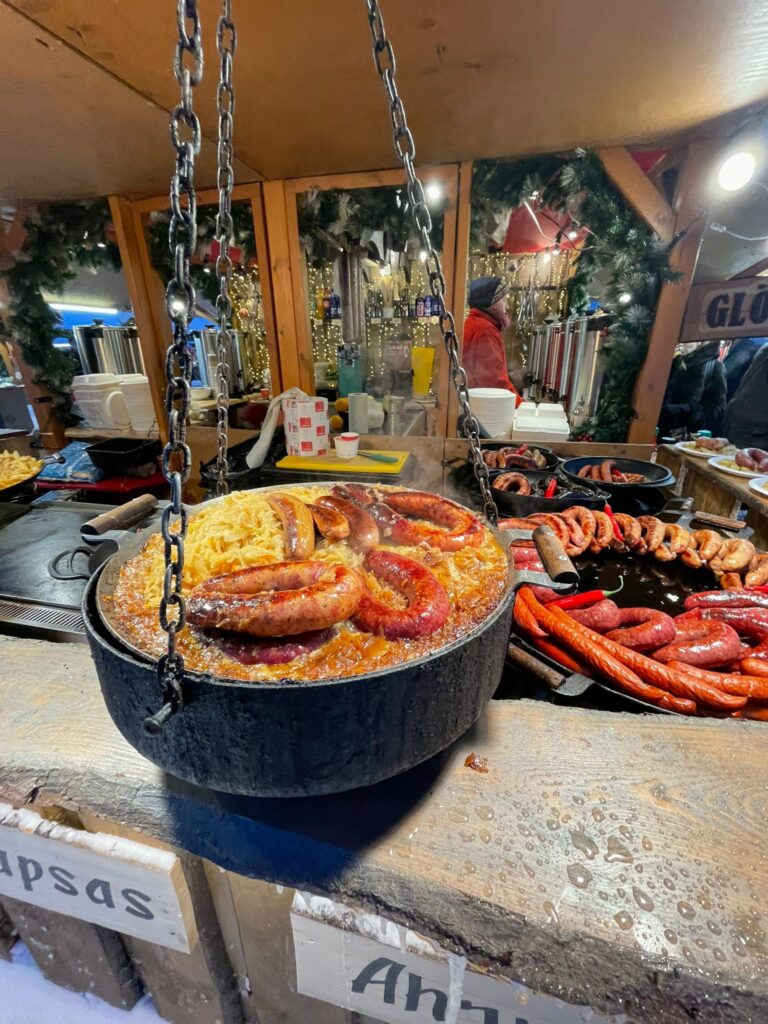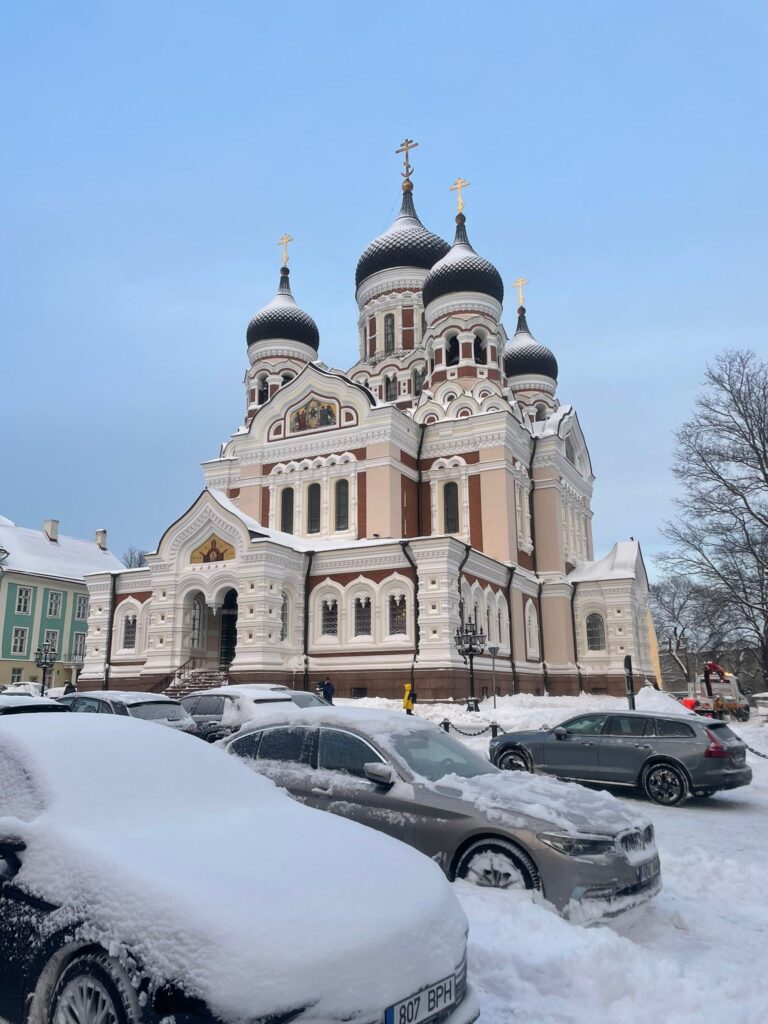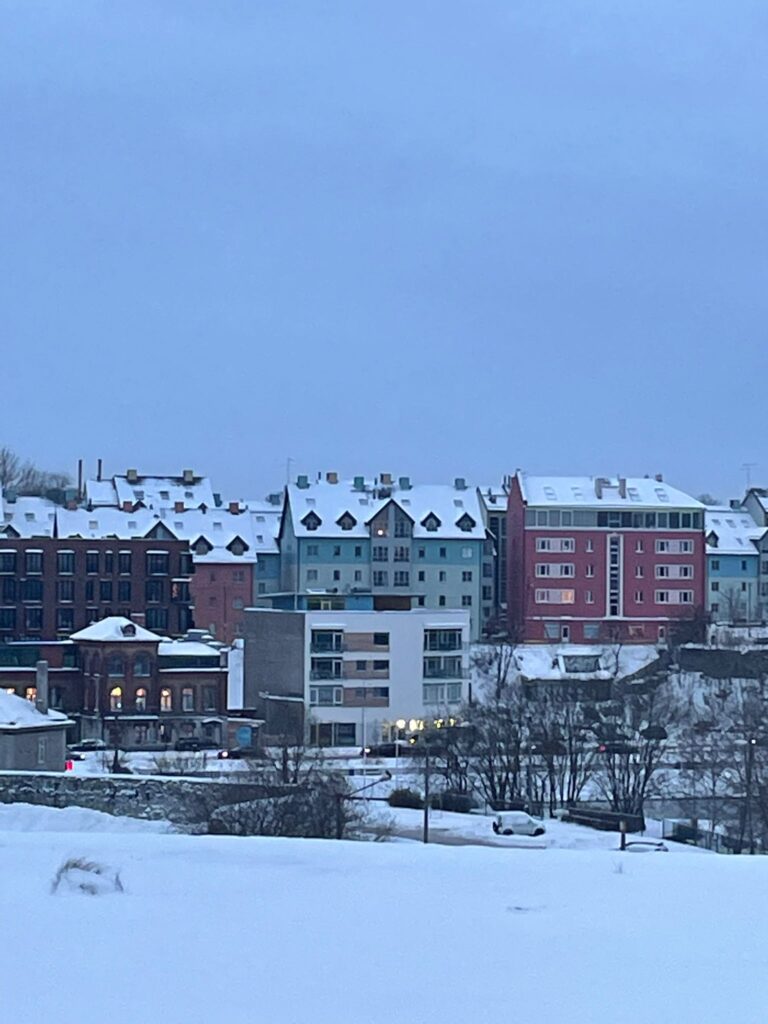The Most Scenic City In Europe: Is Tallinn Worth Visiting?
Disclaimer: Some links on this page may be affiliate links. If you purchase anything through them, I will receive a small commission at no extra cost to you! Further details in the Privacy Policy.
Introduction
Many people who go to the Baltic countries (Lithuania, Latvia and Estonia) will only go to the capitals. This is exactly what I did in December 2022. Which raises the question, is Tallinn worth visiting?
Short answer: yes.
Long answer: read the rest of this post to find out!
Tallinn is a fairly small city, you don’t really need public transport to get around here, although a snow plough may help.
In this post I will talk you through some basic background history of Estonia, provide tips and useful information on visiting the country, and offer enough information for you to decide whether or not Tallinn is worth visiting.

Background on Estonia
As mentioned previously, Estonia is one of the three Baltic countries alongside Lithuania and Latvia. These tiny nations are right on the border between the political east and west. Most people arriving overland will come through Poland. The only other nations connecting them by land are Russia and Belarus. Although Finland offers easy connections by ferry to Tallinn.
The Soviet and Nazi Occupations of Estonia
All three Baltic nations have not had it easy in the last century. They were sandwiched between two sinister superpowers of the 1900s: The Soviet Union (USSR) and Nazi Germany.
All three countries followed a similar path. In 1939, the Molotov-Ribbentrop Pact was signed by the USSR and Germany. They split countries between their borders into either the German or Soviet sphere of influence. Estonia became a part of the USSR through no choice of its own, and the Estonian Soviet Socialist Republic was set up in 1940.
In June 1941, Operation Bararossa began. This was the point at which Nazi Germany betrayed its former friend, and invaded the USSR, including republics such as Estonia.
Estonians were delighted. They believed they would get their country back. Only, the Nazis continued where the Soviets left off, and turned Estonia into a bleak warzone with death camps set up across the country. Suddenly Soviet rule didn’t seem quite as awful, comparatively speaking.
In 1944, the Soviet counterattack was successful in driving the Nazis out, and bringing Estonia under USSR control again for almost 50 years.
Post-War Estonia
After the war, the Iron Curtain descended across Europe, as both a physical and ideological barrier separating east from west. Estonia was very much on the eastern side, controlled by the USSR.
There was no freedom in Soviet Estonia. Everyone was being watched to ensure they did not do anything which harmed the USSR.
A tall skyscraper was set up in Tallinn, with the initial purpose of acting as a hotel for Finnish tourists after the Helsinki-Tallinn ferry service began in the mid-1900s. It was called the Viru Hotel. However, every room was bugged by the KGB, a shady spy organisation for the USSR. Each guest was spied on. Cameras and voice recorders were hidden all over the hotel, allowing the Soviets to track down perceived enemies of the state.

Many Estonians were deported, as part of the USSR’s sovietisation campaign. This was to clear the country of anyone with anti-Soviet views.
The sovietisation campaign also led to a giant Russian Orthodox church being built right in the heart of Tallinn’s most German-populated neighbourhood. The aim was to create a collectivist state where everyone worked towards achieving Soviet values. The reason behind building the church in the German neighbourhood, was to assert dominance and send a clear message that this is the Soviet Union.
Post-Communist Estonia
In 1991, Estonia gained independence from the USSR. A few years previously, reformist leader Mikhail Gorbachev came to power in the USSR. He introduced policies such as glasnost. This was designed to create more freedoms and encourage openness and transparency – two concepts which had certainly not been allowed for much of the USSR’s existence. Gorbachev also enabled perestroika. This was a liberalisation of the USSR’s economic policies. Although not designed as an anti-socialist ideal, it ended up creating a pathway towards the Iron Curtain falling and communism collapsing in the early 1990s.
Estonia wasted no time in becoming friendly with western countries following independence. The country joined the EU and NATO in 2004. It became a eurozone member in 2011, and has been staunchly anti-Russian ever since.
These sentiments became stronger in the wake of the 2022 Russian invasion of Ukraine. Russian president Vladimir Putin has expressed a desire to recreate the USSR. Having previously invaded and occupied parts of Georgia in 2008, the Ukraine war put the Baltic states on red alert. They believe they could be next as small and vulnerable states sandwiched between mainland Russia, and the Russian exclave of Kaliningrad.
Being part of NATO has helped the Baltic states stave off the Russian threat for now. But they are still wary having seen what Putin did first to Georgia, and now Ukraine.

What is Estonian Best Known for Today?
In the modern era, there are two things that Estonia is known for. One is the language. The Estonian language is said to be one of the most difficult to learn in the world. It is a Finnic-Ugric language (alongside Finnish and Hungarian) with 14 grammatical cases, vowel harmony which makes word formation more difficult, and phonetic nuances which are non-existent in other languages.
The other modern claim to fame for Estonia is its reputation as a leading country in cybersecurity. Almost everything can be done safely online including voting and filing taxes. In 2007, Estonia was hit hard by a Russian cyberattack after moving a Soviet war memorial in Tallinn to a less prominent part of the city. Many key systems were down for weeks as a result. They responded by investing a lot of time, money and personnel into becoming a leading cybersecurity country.
Since then, Estonia has been secure and avoided a repeat attack. They have also become home to the NATO Cooperative Cyber Defence Centre of Excellence.
Is Estonia Safe to Visit?
Despite the dark shadow of its eastern neighbour looming over Tallinn, Estonia is very safe to visit.
In terms of crime, Estonia is one of the safest countries in Europe. It is very unlikely that you will become a victim of crime in Tallinn. Theft and violent crime are almost non-existent. Pickpocketing is perhaps the most likely crime you may fall victim to in busy tourist spots, but even the odds of this happening are very low.
You do not have to take any extra precautions as a result of Estonia’s frosty relations with neighbouring Russia, and the threat of a possible Russian invasion. Russia have enough on their hands with Ukraine. With Estonia also being a member of NATO, Russia knows that invading Estonia would have disastrous consequences. Of course, you should keep an eye on the latest news and updates. But as of December 2023, there is no reason to fear any issues related to Russia.
The one danger that Estonia does pose is the weather. This is a cold country and winter temperatures average in the minus figures during the coldest months from December to February. Record lows have been as low as -40 degrees Celsius in the past. Although this is an extreme low and is unlikely to repeat any time soon. Wrap up warm, and find a warm place to stay, then you should be fine.

When is the Best Time to Visit Estonia?
For the best weather, you want to visit in the summer months from June to August. Although the shoulder season of May and September may be preferable for the perfect balance of warm weather and lower crowds/costs.
Estonia does however have some ski resorts, which means skiing fans will enjoy Estonia best between November and February. This is when the snowfall is at its heaviest.
Speaking from personal experience, I would say December is the best month to visit Estonia, and Tallinn in particular. This is because the Christmas markets are up-and-running and provide a magical winter experience for anyone visiting. Tallinn is certainly worth visiting at this time of year. I would highly recommend it if you can brave the Baltic freeze.

How to Visit Estonia
Estonia is a member of the Schengen Area, and therefore applies Schengen entry rules. You do not need a visa to visit Estonia from Europe or the mainland Americas with a small number of exceptions. Citizens of the following countries do require a visa: Belize, Bolivia, Ecuador, Guyana, Suriname, Kosovo, Belarus and Russia.
On the other hand, citizens of most other countries require a visa to visit Estonia. Notable exceptions include Japan, South Korea, Taiwan, Australia, New Zealand, Malaysia and the UAE. Most other exemptions apply to small island nations.

How to get to Estonia
There is one international airport in Estonia. Lennart Meri Tallinn Airport (TLL) in the capital is the only airport that offers commercial flights to other countries. Tartu hosted the other international airport in the country (TAY), although this has not been operational for tourists in the last year. Tallinn connects Estonia with most major European countries. The notable exceptions and Portugal and Romania. Georgia is the only country outside of mainland Europe with connections to Tallinn.
Buses operate from neighbouring Latvia and Russia. As with Finland, Estonia has had issues with Russia sending asylum seekers across the border as an act of aggression against NATO. Finland recently (as of December 2023) closed its border with Russia for this reason. Estonia is now being inundated with migrants who would otherwise have been sent to Finland. Because of this, they warn their border with Russia could close at short notice. Check out the Estonian Police and Border Guard site for the latest information on the status of the Estonia/Russia border.
As a result, you should be wary of relying on transport from Russia. But entering Estonia from Latvia is fine. Buses between Riga and Tallinn are regular.
It is also possible to reach Estonia by boat. There are ferries from both Stockholm in Sweden, and Finnish capital Helsinki. The Helsinki/Tallinn route is one of the most popular sea routes in Europe, so it’s pretty easy to get to Tallinn from Finland.
How to get Around Estonia
There is a train network covering good chunks of the country. Use the Elron website for information on train times, routes and tickets.
For the best coverage of destinations across the country, buses are your best option. Use the Tpilet website to find bus tickets covering most of Estonia.
Domestic flights in Estonia operate primarily between the mainland and the islands.
Is Tallinn Cheap to Visit?
Tallinn is expensive compared to the (outdated) reputation Estonia has as a cheap destination. However it is still very cheap compared to Western Europe or the Nordic countries.
Accommodation is very cheap. You can find a hostel bed in Tallinn for £8 ($10) per night. Zinc Old Town Hostel, Imaginary Hostel, Viva Nord Hostel and Majaka Hostel all offer beds for this price. Their reviews range from average to terrible however, so have a good read before staying in one of these. I stayed in Imaginary Hostel and have written a short review below.
For a private room, prices generally start from around £20 ($25). There are also many apartments, with costs starting around halfway between the cost of a dorm bed and a private hotel room. Of course, the cheapest spots however generally aren’t the best. So be sure to read the reviews before booking anywhere.
Dinner isn’t exactly at bargain-basement level in Tallinn. Expect to pay around £10-15 ($13-19) for an average meal in the Estonian capital.
Transport is one area where you should be able to save some money. The city is very walkable, so you don’t really need transport at all. If you do however, there are frequent buses and trams as well as trolleybuses. Since May 2023 it has cost 5.50 euros (£5/$6) for a 24-hour ticket on Tallinn’s public transport systems. It is 2 euros (£2/$3) for a single one-hour ticket.

Where is Worth Visiting in Tallinn?
The Old Town. Tallinn is worth visiting for this alone. The Old Town is a medieval settlement within the heart of the city, where you can see beautiful turrets that look like something out of a fairytale.
Do a Free Walking Tour in Tallinn
The best way to explore this is via a free walking tour. Despite the name, these tours are tips-based (well they can be free, if you’re a terrible person. The tips pay the guide’s wages). The tours generally average around 2 hours in length. They involve a local guide taking you around their city, showing you the best spots, and telling you a lot of the history for the city.
Free walking tours are a great tip for any city you visit, but they are certainly a great way of getting to know Tallinn.

Alexander Nevsky Cathedral
Alexander Nevsky Cathedral is one of the most beautiful religious buildings in Europe. This Russian Orthodox church was built right in the heart of Tallinn’s German neighbourhood. It is free to enter, although you are not allowed to take photos of the inside.

Toompea Castle
Directly opposite Alexander Nevsky Cathedral is Toompea Castle. This medieval castle has been repurposed in recent times as Estonia’s parliament building. The castle is famous for its pink appearance, and is worth a glance if you’re in the area.

Estonia Theatre
The Estonian National Opera and National Symphony Orchestra can be found here. If that’s your area of interest, you may be interested in coming to check the theatre out. However, if you are a history enthusiast with zero interest in the arts, there is something for you here too.
Outside the theatre is a statue of controversial ex-leader of Estonia, Konstantin Pats. The former President was in charge of the country from 1938-1940. Although he was soon arrested and deported to Russia, where he died after 16 years of imprisonment in psychiatric hospitals. He was kept in these hospitals for repeatedly claiming to be the President of Estonia. His resignation was forced by the USSR. Many still saw him as the legitimate leader of the country.

Hotel Viru and the KGB Museum
Remember Hotel Viru which was bugged by the KGB to spy on Finnish tourists? Well, it’s now been converted into a museum dedicated to the shady spy organisation. It costs from 13 euros (£11/$14) to visit for an adult, and half that for a child.
Apparently the hotel details all the murky operations of the KGB during Estonia’s period of Soviet occupation. Although I decided against visiting myself, having been to a similar museum in Lithuania just over a week previously.
Christmas Markets in Tallinn (December/Early January Only)
Head to Town Hall Square between December and the first week of January, and you will come across the wonderful festive markets. A series of (often) snow-covered stalls sell a variety of festive goods including popular Estonian Christmas cuisine. Examples include sauerkraut or gingerbread.
A stage stands to provide entertainment from locals, usually in the form of carol singing, or other festivities. Meanwhile, there are lots of funfair-style rides for children including a small carousel and a mini train. Tallinn is one of the most beautiful cities in the world for getting in the Christmas spirit.

So… Is Tallinn Worth Visiting Then?
Tallinn is certainly worth visiting regardless of your interests. It has something for everyone, and this is just a surface-level overview of what to expect.
Where to Stay in Tallinn
I only ever review places I’ve actually been to. Therefore this isn’t “a comprehensive guide to the best hotels in Tallinn”. Rather, it is a series of mini reviews (one review in this case) of places I actually stayed at.
Tallinn – Imaginary Hostel (£8/$10 Per Night)
Pros
The location was very good, just on the outskirts of the Old Town. It also had a nice small quiet room where you could escape from the noise for a bit.
Cons
The lockers were outside the dorm rooms in the main corridors, and far too small regardless. The showers were dreadful. They had little or not hot water. On the rare occasions where they did have some, you would have to press a button every 30 seconds to keep the hot water running. Despite having a large social area, there’s no real atmosphere here.
Overall
It’s an okay place to stay, but that’s it. I don’t think Imaginary Hostel will be on anyone’s list of top hostels. It’s cheap and convenient, but no more than that. This place is for you if your primary concern is price. For anything else, you are better off heading elsewhere. My rating: 6/10.
Final Thoughts: Is Tallinn Worth Visiting?
Yes. Tallinn is a beautiful city and I would say it is well worth visiting in December to enjoy the Christmas markets as well as the beautiful winter scenery. The positives by far outweigh the negatives of going when it’s freezing cold.
Having been to around half of Europe’s countries, Estonia easily surged into my top 5 on the continent, and I would call it one of Europe’s top solo travel destinations. In fact, Latvia and Lithuania fit into the same category. The three Baltic countries all have enough differences to make each worth seeing, yet there are also many similarities. This is a good thing when they each carry so much charm.
Would I say there are any negatives about visiting Tallinn? Normally the cold weather would be one. But you can’t have pretty snowscapes and Christmas markets in Europe without a bit of a chill. So perhaps this doesn’t count as such a bad thing. Also an ultra-cheap hostel designed specifically for backpackers would be a plus. The hostels Tallinn has don’t quite have the feel of places catering specifically for backpackers. Having stayed in an estimated 150+ hostels around the world, I have a feel for a good one. Despite staying in one of Tallinn’s apparent best, it wasn’t particularly good.
But at the end of the day, I cannot recommend Tallinn enough. It’s a truly wonderful city and should absolutely be on your bucket list for Europe.
I’m currently on a journey to visit every country in the world. If you want to read some history, facts, opinions, stories and travel advice on each country I’ve been to so far, my destinations page lists everything on this blog.

